Find Affordable Yarn Substitutes for Creative Expression and Saving Money on Crochet
Maybe you already know how to crochet — but do you know how to crochet without yarn? If you’ve only crocheted with yarn up until this point, crocheting without it might seem like an impossibility. I assure you, it isn’t! I hope you’ll be excited to learn the secrets for crocheting without yarn.
The most important thing to know is this: You can crochet with just about any material that has characteristics similar to yarn:
- It has to be pliable enough to wrap easily around a crochet hook.
- It has to be capable of being made into strands that are long enough for you to crochet your intended project with it.
- Preferably, you should be able to wind it up into a ball or organize it on a spool, cone or holder so you can unwind it and crochet with it like you would with yarn.
I invite you to sit for a moment and brainstorm. How many materials can you think of that could have these characteristics?
7 Fantastic Yarn Alternatives Plus One REALLY BAD IDEA to Avoid
Here are some of the things that other crafters are using instead of yarn to crochet with:
1. Fabric
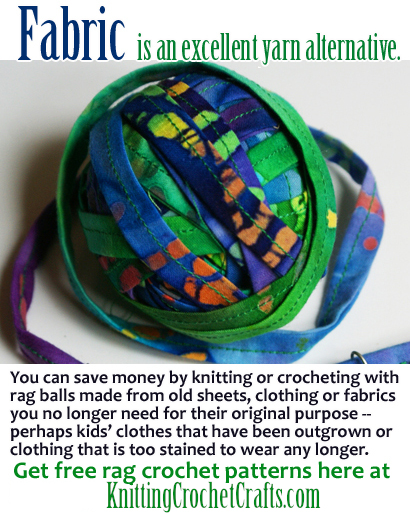
Sooner or later, just about everyone ends up with stained / torn / outgrown clothing, worn out sheets, and textiles that just plain don’t work any more for whatever purpose you originally needed them. If you have bunches of these old duds hanging around, fabric crochet is the ideal technique for upcycling them.
Learn How to Crochet With Fabric — You won’t have to learn any new stitches to be successful with fabric crochet. In fact, most of the time, you’ll be using the simplest basic stitches when you crochet with fabric.
The most important new skill you’ll need for fabric crochet is an understanding of how to make fabric strips that are of just the right quality for crocheting with. Check out our article on how to make a rag ball if you want to get started with that.
Once you process your fabric strips to work with, crocheting with fabric is almost the same as crocheting with yarn. Yarn is generally easier to work with than fabric is, but the biggest difference I’ve noticed is just the time commitment for processing all those fabric strips.
This technique has many advantages:
- It’s eco-friendly.
- It’s frugal; if you harvest your fabrics from your old unwanted clothing and household items, it’s even cheaper than the cheapest yarn.
- It’s colorful and beautiful with huge potential for making interesting projects. The technique is ideally suited for making rugs, potholders, coasters, mats, purses, tote bags and bunches of other lovely projects.
2. Wire
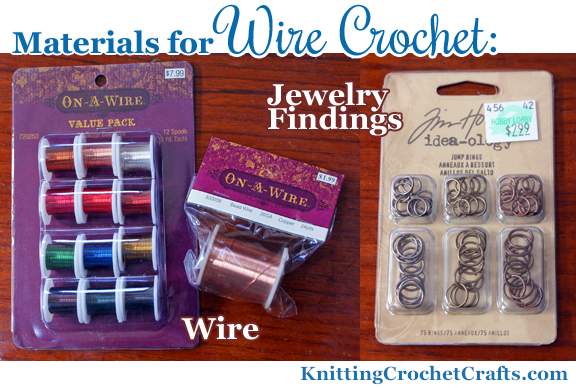
Wire is one of my favorite alternative materials to crochet with. When I design small, simple crochet patterns intended for use with yarn, I often try adapting the same design into wire to see how it will work out. I’ve come up with some really fun projects that way, and you could do the same thing.
That said, if you’ve never tried wire crochet before, for your first wire crochet project, I recommend using a pattern that was specifically intended to be a wire crochet pattern. I have a beginner’s wire crochet tutorial that is ideal to use for that purpose.
Beyond that, I have many other wire crochet patterns available. Some of them are jewelry designs that incorporate wire and other findings. Some of them are napkin rings.
I bet you can brainstorm bunches of other fascinating possibilities: how about sculptures, boxes, and baskets?
Learn How to Crochet With Wire: If you’d like to learn a technique for crocheting with wire, there’s a free tutorial you can use. The tutorial gives you step-by-step instructions for how to make a set of beaded wire napkin rings. This is one of the simplest possible projects you could make with the technique, but the results are really stunning; the napkin rings look fancy and elegant, and you’ll be proud to set your table with them.
Note that wire work can be really hard on your hands — it’s harder to work with than yarn is — so please use caution and common sense when working with it. This is not something you want to risk doing if you are already coping with repetitive stress injuries or other problems of that ilk.
3. Plastic Bags
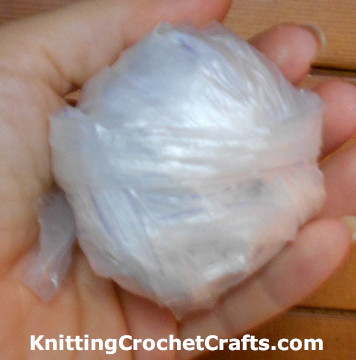
You can cut plastic bags into strips and crochet with them in much the same way you do with fabric. People are using plastic bags to crochet all kinds of interesting projects including purses, tote bags, pouches, exercise mats, bedrolls for the homeless, pot scrubbers and more.
“Plarn” is the term some crafters are using to describe the cut-up strips of plastic bags that people are using to knit and crochet with. Click here to check out a free step-by-step tutorial for how to make plarn.
See Also: Crochet Plastic Bags — This page has a couple of easy, free crochet plarn patterns you can try.
4. Ribbon
I enjoy crocheting with ribbon. Back in the days when scrunchies were trendy, I used to use ribbon to crochet around hair elastics to make scrunchies. I don’t currently have any ribbon crochet patterns available, but if you have any hair accessory or other small accessory patterns that seem suitable, you could try substituting narrow ribbon for yarn to see how it turns out.
.
5. Raffia
I’ve never actually crocheted with raffia, but I know it can be done. I collect vintage crochet patterns. One of my favorite vintage publications is Home Needlework Magazine; it is one of the best sources I know of for interesting historic crochet patterns. I’m telling you this right now because the June 1915 issue of Home Needlework Magazine has a lovely, fascinating pattern for a child’s hat crocheted using raffia twine.
6. Rope, String and Twine
The hardware store can be an interesting source of alternative crochet materials including rope, string and twine.
7. Handspun, Plied Newsprint = “Narn”
Did you know that you can spin paper into long, yarn-like pieces?
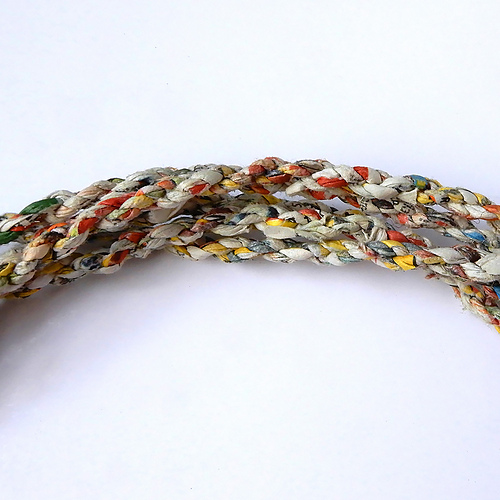
This idea comes to you from a crafter named Erica, who goes by the nickname @sierrapelona on Youtube and Ko-Fi.
Important Note: Neither Erica nor I have tried crocheting or knitting with handspun paper yet to see how it will work out. We think it’ll work, but at this point, we have no idea. So, if you try this, please let us know how it works out for you!
If it ends up not working out for crocheting or knitting with, there are plenty of other possibilities, though; it would be useful in all kinds of paper craft projects.
Erica says,
“I always have plenty of free newsprint to work with from the advertising circulars that show up in my mailbox every week, so i thought i’d do some experiments.”
I ran 2 sheets through my paper shredder into 1/4” strips, misted them lightly while spinning and plying, and wound up with 2.5 yards of colorful 4-ply narn.
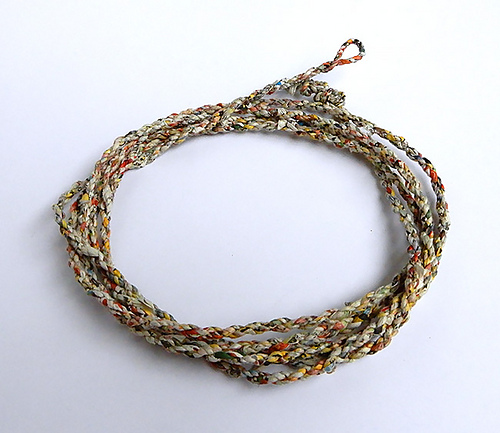
Here you can see skeins of “Narn” that used to be newsprint catalogs:
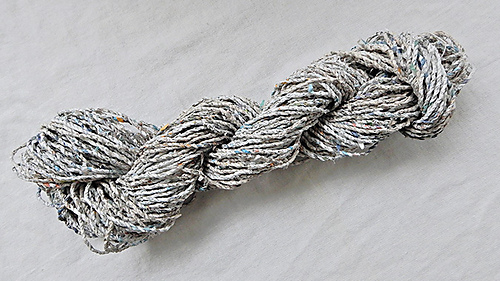
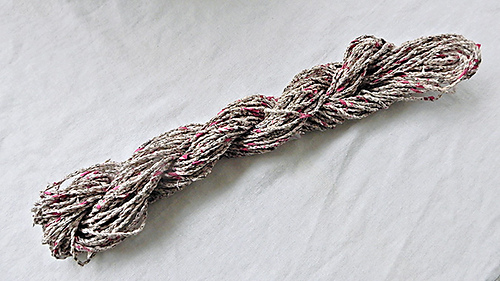
Here you can see a skein of “Narn” that used to be a legal pad.

Erica says,
“My plans are to make runners or rugs, and possibly tote bags. Depending on swatching results and available yardage, I may also make a wallhanging or basket.
I don’t know about you, but I find these ideas really and truly inspiring.
If you decide to try making “narn” for yourself, what kinds of projects would you attempt to make with it? We’d love to hear your suggestions in the comments section below.
8. The Tape from Old VHS Video Cassette Tapes and Other Tapes
Some people pull the tape out of old cassettes and VHS video tapes to crochet with. At first, I was enthusiastic about this idea — but now that I’ve learned more, I can’t in good conscience recommend doing this due to toxicity concerns. These old tapes are coated with materials including chromium and cobalt that can flake off and create what’s called “black dust” that you really do not want to breathe, touch or otherwise come into contact with. Exposure can cause or contribute to lung cancer and other health problems. For these reasons, tapes are really not a wise yarn alternative.
Now you’re updated on how to crochet without yarn. I hope you found this info enlightening, inspiring and helpful. I welcome your comments and would love to hear about your experiences crocheting or knitting with these or other alternative materials.
See Also: How to Save Money on Knitting and Crochet
Over to You:
Have you tried crocheting without yarn? If so, what did you use? What did you make? And how did it turn out? Let’s talk about your experiences in the comments.
References
By Amy Solovay
This page was last updated on 10-15-2025.